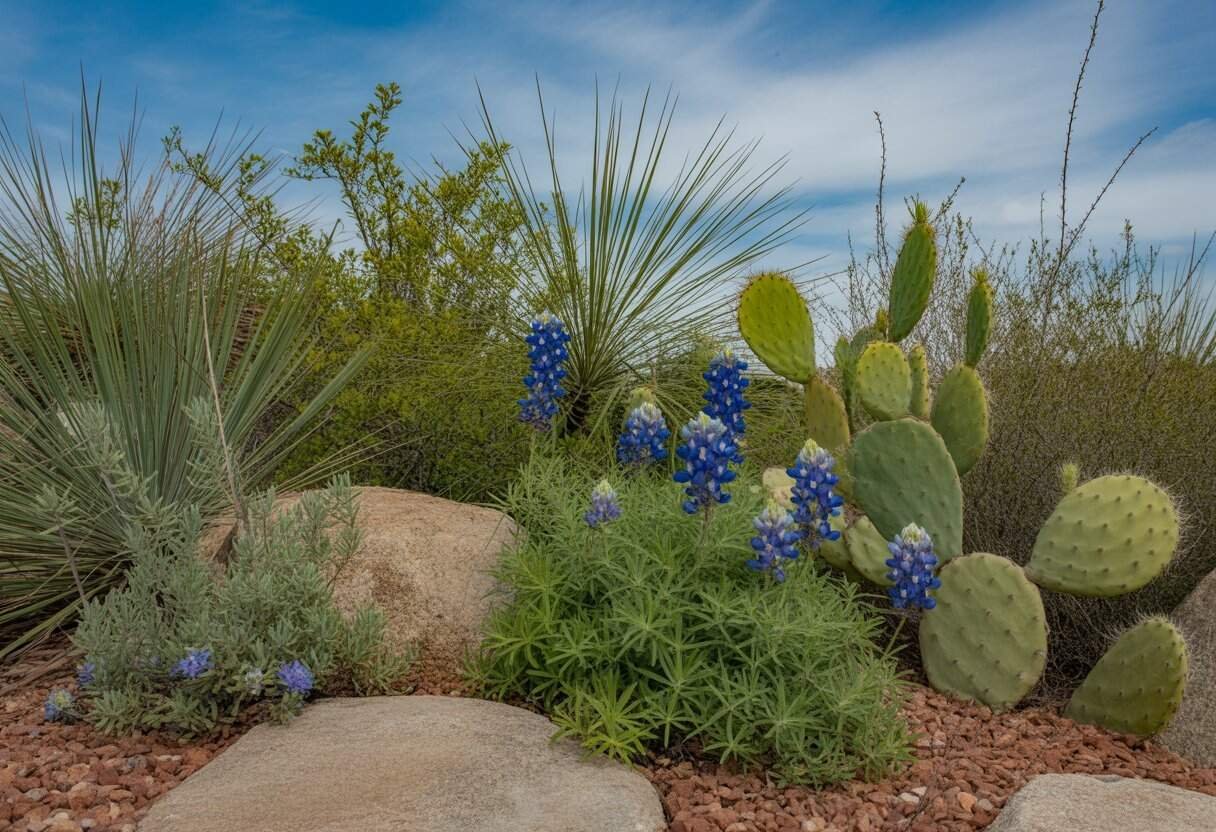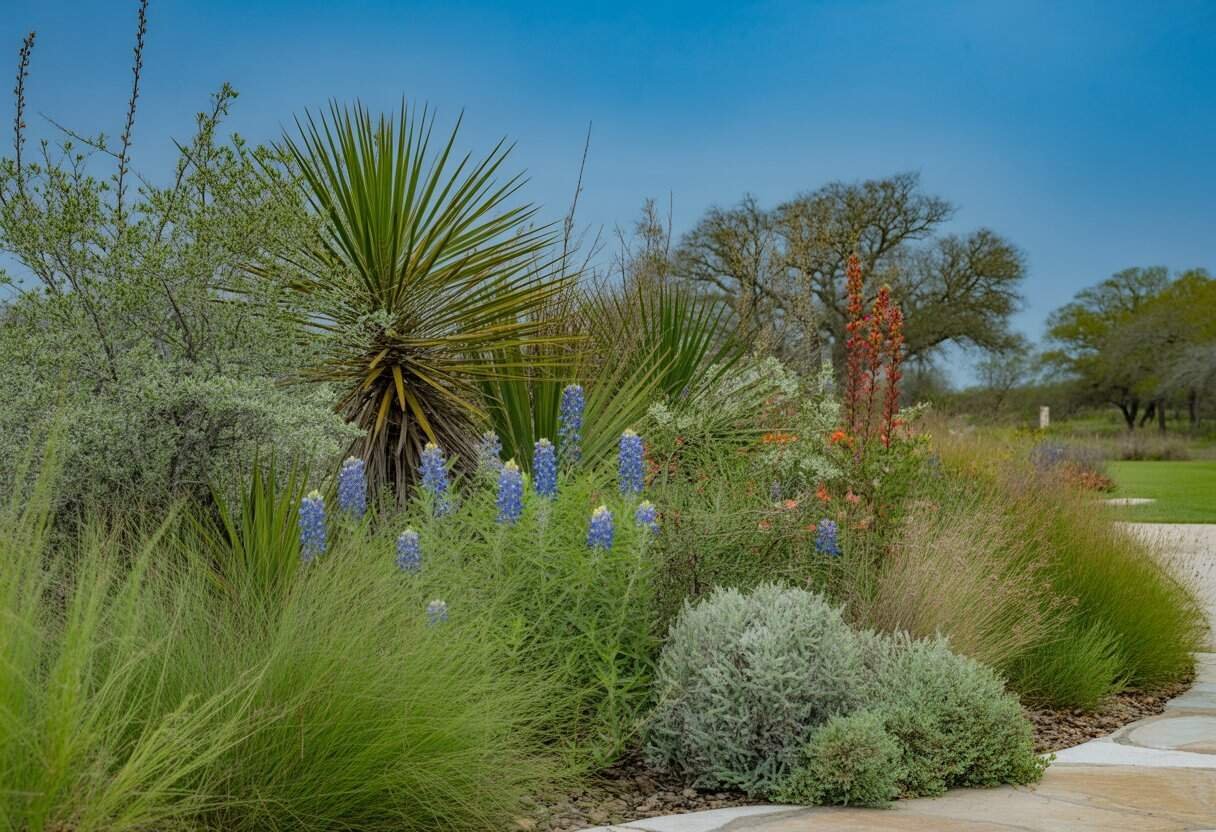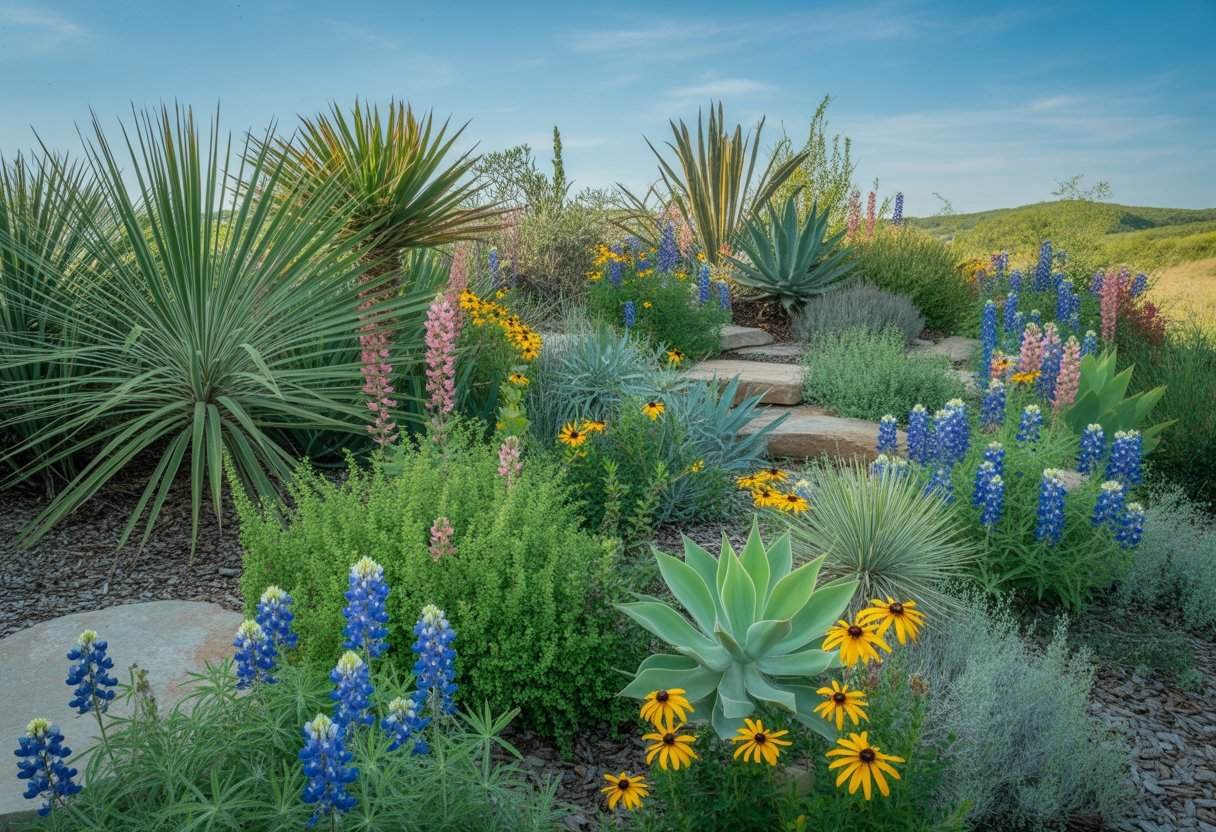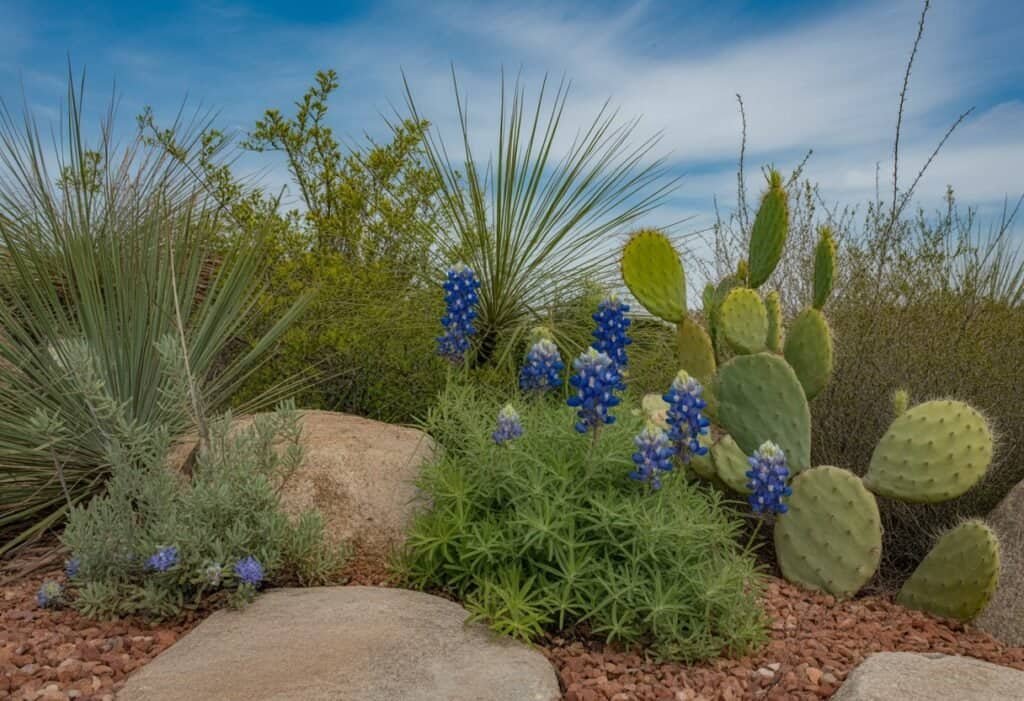Looking for a beautiful, low-maintenance landscape that thrives in Texas? Native plants are the perfect solution for your yard.
These plants have evolved in our local climate and soil conditions. They naturally withstand Texas weather extremes.

Native Texas plants need less water, fertilizer, and pest control than non-native species. This saves you time and money while creating a beautiful landscape.
They provide habitat for local wildlife, including birds, butterflies, and beneficial insects. These creatures help keep your garden healthy.
From vibrant wildflowers like bluebonnets and black-eyed Susans to sturdy trees like live oak and Texas mountain laurel, you can find native options for every part of your landscape. These plants offer year-round interest with their diverse colors, textures, and growth habits.
Key Takeaways
- Native Texas plants are adapted to local conditions and need less water and maintenance than exotic species.
- Using native plants in landscaping creates habitat for local wildlife and reduces the need for fertilizers and pesticides.
- Texas offers a wide variety of native plants for every landscaping need, from colorful wildflowers to drought-resistant trees and shrubs.
Benefits of Using Native Texas Plants in Landscaping

Native Texas plants offer many advantages for homeowners and landscapers. These hardy species thrive in Texas conditions and solve common gardening challenges.
Environmental Advantages
Native plants have adapted to local soil and climate over thousands of years. They need fewer fertilizers and pesticides than non-native species.
Texas native plants develop deep root systems that help prevent soil erosion during heavy rains. These plants improve air quality by reducing the need for gas-powered maintenance equipment.
Native plant gardens produce less yard waste. They also avoid chemical treatments that can harm beneficial insects.
Texas natives support biodiversity by preserving the region’s ecological balance. They help maintain healthy soil microbes and fungi that support the entire ecosystem.
A diverse native plant garden creates a more resilient landscape. It can handle temperature extremes and recovers quickly from environmental stresses.
Water Conservation and Xeriscaping
Native Texas plants use less water in landscaping. Many species survive on rainfall alone once established.
This water efficiency leads to lower utility bills and less maintenance. Xeriscaping with drought-tolerant plants like Texas sage and black-eyed Susans creates beautiful landscapes with minimal watering.
These plants have evolved ways to collect and conserve moisture even in harsh conditions. With proper soil preparation, native plants need deep but infrequent watering.
Their extensive roots access moisture deep in the soil. This makes them ideal for areas with watering restrictions or drought.
Most Texas natives prefer well-drained soil and do not need extra moisture. Their drought resistance removes the need for complex irrigation systems and reduces maintenance costs.
Supporting Pollinators and Wildlife
Texas native plants provide food and habitat for local wildlife and pollinators. They produce nectar, pollen, seeds, and berries that sustain birds, butterflies, and beneficial insects.
Native plant gardens create habitat corridors in urban and suburban areas. These green spaces let wildlife move safely between larger natural areas.
Species like butterfly weed, black-foot daisy, and flame acanthus attract many pollinators. Native gardens naturally support the life cycles of beneficial insects and birds.
Many Texas natives serve as host plants for butterfly larvae and provide nesting materials for birds. A garden with Texas natives helps support pollinators like hummingbirds, bees, and butterflies.
Even small native gardens provide food and shelter for wildlife.
Selecting the Ideal Native Texas Plants

Choose native Texas plants by understanding your growing conditions and landscape goals. Plants that match your soil and light exposure will thrive with little care.
Assessing Soil Conditions
Texas soils vary across the state. Sandy soils in East Texas drain quickly, while clay soils in Central Texas hold water longer.
Test your soil’s pH level with a home kit before selecting plants. Most Texas native plants prefer well-drained soils.
If you have heavy clay, add compost to improve drainage. Purple Coneflower and Black-eyed Susan tolerate clay soils.
For alkaline soils, choose plants like Texas Sage and Blackfoot Daisy. In acidic soils, American Beautyberry and Turk’s Cap thrive.
Soil depth matters too. Shallow soils suit plants with fibrous roots better than those with deep taproots.
Sunlight, Shade, and Climate Needs
Watch how sunlight moves across your yard during the day. Most Texas native plants need full sun (6+ hours daily).
For shady spots, try these natives:
- Full shade: Turk’s Cap, Inland Sea Oats, Texas Ferns
- Partial shade: Columbine, American Beautyberry, Cedar Sage
North Texas has colder winters, so use hardier plants like Texas Redbud and Yaupon Holly. Coastal areas need salt-tolerant species such as Gulf Muhly and Saltbush.
The Hill Country’s limestone soils and hot summers favor drought-resistant plants like Cenizo and Agarita. Group plants with similar water needs together for efficient irrigation.
Low-Maintenance Landscaping Choices
Native plants evolved in Texas and need less water, fertilizer, and care than non-natives. For low-maintenance landscaping, try these performers:
Drought-resistant options:
- Texas Sage (Leucophyllum frutescens)
- Blackfoot Daisy (Melampodium leucanthum)
- Mexican Feathergrass (Nassella tenuissima)
Native groundcovers like Horseherb and Frogfruit reduce mowing and provide pollinator habitat. Many Texas natives need almost no fertilizer.
Over-fertilizing can cause excessive growth and reduce flowering. Texas Mountain Laurel and Flame Acanthus resist most pests, so you spend less time on pest control.
Popular Native Texas Flowering Plants
Texas landscapes thrive with native flowering plants that provide beauty and need less maintenance and water than non-native species. These plants have adapted to Texas soils and climate, making them excellent for sustainable gardening.
Wildflowers for Colorful Displays
Texas bluebonnets create stunning blue carpets in spring. These iconic flowers grow easily from seed and attract pollinators.
Black-eyed Susans (Rudbeckia hirta) have bright yellow blooms with dark centers. They’re drought-tolerant and bloom all summer.
Mexican Hat shows off reddish-brown petals that droop around a raised cone. This wildflower thrives in poor soil and full sun.
Purple coneflower stands strong through summer with pink-purple petals and a spiky orange-brown center. These sturdy plants reach 2-3 feet tall and attract butterflies.
Lemon beebalm has citrus-scented leaves and delicate lavender flowers. It spreads well in meadow-style gardens.
Top Blooming Shrubs
Texas mountain laurel produces clusters of purple, grape-scented flowers in early spring. This evergreen shrub grows slowly to 15 feet and tolerates drought.
Texas lantana offers orange, yellow, and red flowers from spring until frost. This low-growing shrub spreads 3-6 feet wide and attracts butterflies and hummingbirds.
Flame acanthus, or hummingbird bush, has tubular orange-red flowers all summer. It grows 3-4 feet tall and recovers quickly from freezes.
Autumn sage (Salvia greggii) blooms nearly year-round in many Texas gardens. Available in red, pink, purple, and white, this compact shrub rarely exceeds 3 feet tall.
American beautyberry (Callicarpa americana) features clusters of bright purple berries in fall. Birds love the berries, and the shrub’s arching branches add graceful structure.
Perennials for Year-Round Appeal
Gregg’s mistflower forms clouds of blue-purple blooms in fall. This easy perennial spreads by runners and attracts butterflies.
Gayfeather sends up purple spikes that bloom from top to bottom. These drought-tolerant perennials thrive in poor soil.
Rock rose tolerates extreme heat and drought. Its pink flowers look like small roses and appear after rain.
Copper Canyon daisy bursts with bright yellow flowers in fall when many plants stop blooming. Its foliage has a marigold-like scent.
Dalea frutescens (Black dalea) produces small purple flowers along delicate stems. This perennial forms a 2-3 foot mound, great for rock gardens or borders.
Native Grasses and Groundcovers for Texas Lawns
Texas native plants provide beautiful, low-maintenance alternatives to traditional turf. These plants have adapted to local conditions over thousands of years and naturally resist drought.
Best Ornamental Grasses
Little Bluestem (Schizachyrium scoparium) stands out for Texas landscapes. This grass grows 2-4 feet tall with blue-green summer foliage that turns reddish-copper in fall.
It thrives in full sun and needs little water once established. Indian Grass (Sorghastrum nutans) reaches 3-5 feet with golden seedheads that catch the light.
This grass once dominated the Blackland Prairie and supports native birds and insects. Switchgrass (Panicum virgatum) offers excellent erosion control on slopes.
Its upright form creates winter interest with airy seedheads that last through the cold months. Different varieties provide options for height and color.
Cut these grasses back once a year in late winter to keep them looking good.
Groundcover Options for Challenging Spots
Frogfruit (Phyla nodiflora) excels where other plants struggle. This low-growing native spreads quickly to form a dense mat of small leaves and tiny white flowers that attract butterflies.
It can handle light foot traffic and grows in sun or partial shade. Blackfoot Daisy (Melampodium leucanthum) offers white blooms year-round in tough conditions.
Growing just 10-12 inches tall, it forms a mound perfect for borders and rock gardens. This plant thrives in poor, rocky soil.
Horseherb works well in shady spots where grass won’t grow. Its bright green leaves and small yellow flowers create a lush carpet under tree canopies.
These groundcovers need little maintenance and reduce watering, fertilizing, and mowing.
Creating a Meadowscape
Converting part of a lawn to a native meadow creates a beautiful, valuable landscape. Start small, such as with a 100-square-foot area, by removing existing turf and weeds.
Plant a mix of native grasses like Little Bluestem and Indian Grass as the base (about 40% of the meadow). Add flowering perennials for color and pollinator support.
Space plants according to their mature size. New meadows need regular watering during the first year.
After that, rainfall usually provides enough moisture. Mow just once each year in late winter to remove dead material and prevent woody growth.
A well-designed meadowscape recreates the beauty of the Blackland Prairie and removes the need for fertilizers, pesticides, and weekly mowing. The deep roots of native plants improve soil health and provide strong drought resistance.
Drought-Tolerant Shrubs and Trees
Texas landscapes thrive with native drought-resistant woody plants. These hardy shrubs and trees need minimal water once established.
They have evolved to withstand the state’s challenging climate. At the same time, they provide beauty, shade, and habitat for local wildlife.
Iconic Texas Shrubs
Texas Sage (Leucophyllum frutescens), also called Cenizo, stands as the most recognizable drought-tolerant shrub in Texas. Its silvery-gray foliage and purple blooms appear after rain, earning it the nickname “barometer bush.”
Red Yucca (Hesperaloe parviflora) isn’t a true yucca but offers striking coral-colored flower stalks that attract hummingbirds. This evergreen perennial thrives in rocky, dry soil.
Yaupon Holly (Ilex vomitoria) grows as a small tree or large shrub with bright red berries that persist through winter. It adapts to many soil types and sun exposures.
Dwarf Palmetto (Sabal minor) brings tropical texture to shaded spots. This hardy palm relative grows slowly and requires almost no maintenance once established.
The delicate Anacacho Orchid Tree (Bauhinia lunarioides) produces white butterfly-shaped flowers in spring. It stays compact at 6-12 feet tall, making it perfect for smaller landscapes.
Native Trees for Shade and Structure
Bald Cypress (Taxodium distichum) grows along waterways but shows surprising drought tolerance once established. These stately trees develop distinctive “knees” in wet conditions and display beautiful russet fall color.
Ashe Juniper, often called cedar, covers much of the Texas Hill Country. Female trees produce blue berries valuable to wildlife.
Chinquapin Oak offers dappled shade with its medium canopy and attractive bark. It grows more slowly than Live Oak but becomes highly drought-tolerant.
Live Oak remains the quintessential Texas tree. Its broad, sprawling canopies can span over 100 feet.
These nearly evergreen trees drop leaves briefly in spring rather than fall. Southern Sugar Maple brings spectacular fall color to Texas landscapes.
This native alternative to non-native maples needs less water and tolerates alkaline soils better.
Evergreen and Deciduous Options
Texas landscapes benefit from a mix of evergreen and deciduous woody plants. Evergreens like Yaupon Holly and Ashe Juniper provide year-round screening and wildlife habitat.
Deciduous shrubs like Flame Acanthus and American Beautyberry offer seasonal interest with dramatic flowers and colorful berries. They also conserve energy by dropping leaves during drought.
When planting drought-tolerant woody species, water regularly for the first two years. This practice helps plants develop deep root systems that later access groundwater without extra irrigation.
Many native woody plants thrive with occasional deep watering during extreme drought. Apply water at the drip line, not at the trunk base.
Plant native trees and shrubs in fall or early spring. This timing allows roots to establish before summer heat arrives.
Design Ideas for Native Plant Gardens
Native Texas plants can transform any landscape into a beautiful, low-maintenance garden. These designs work with nature, creating spaces that feel authentic to Texas.
Creating a Rock Garden
Rock gardens showcase the rugged beauty of Texas landscapes. They provide perfect growing conditions for drought-tolerant natives.
Start with varying sizes of limestone or granite rocks arranged in natural-looking groupings. Between rocks, plant succulents like prickly pear cactus, which adds dramatic form and vibrant yellow flowers in spring.
Small yuccas and agaves create strong architectural elements that stand out year-round. For color, add blackfoot daisy or four-nerve daisy, which thrive in well-drained soil.
In Hill Country areas around New Braunfels, use local rock formations for an authentic look. Water features like small dry creek beds add visual interest and serve as drainage solutions during heavy rains.
Accent Plants for Curb Appeal
Strategically placed native plants can enhance a home’s curb appeal. For entryways, consider ornamental grasses like Gulf muhly, which catch the afternoon sun beautifully.
Red yucca makes an excellent statement plant with tall flower stalks above slender leaves. These plants draw the eye to focal points and need minimal care.
For seasonal color, Texas lantana offers orange and yellow blooms that attract butterflies from spring through fall. Plant them in clusters for maximum impact.
In San Antonio gardens, espadaña (cattails) add vertical interest near water features. Texas mountain laurel serves as a small ornamental tree for front yards, with fragrant purple flowers in spring.
Native shrubs like agarita provide structure and screening with almost no maintenance once established.
Sustainable Ranching and Large-Scale Projects
Large properties and ranches benefit from native landscaping approaches that reduce maintenance costs and support wildlife. Converting parts of grazing land to native prairie requires initial preparation but reduces mowing and irrigation.
For ranch entrances and buildings, create islands of native landscaping using buffalo grass for open areas. Cluster larger species like Texas persimmon or mesquite for shade.
These plantings create natural windbreaks and wildlife habitat. Espadaña and other water-loving natives stabilize pond edges and prevent erosion.
For large-scale erosion control, sideoats grama (Texas state grass) provides excellent soil stabilization on slopes. Mark property boundaries naturally with stands of yucca or prickly pear, creating living fences that need no maintenance.
These plantings support pollinators and beneficial insects that help neighboring agricultural areas.
Plant Care and Maintenance in Texas Landscapes
Proper care of native Texas plants helps them thrive and conserve resources. These plants need specific maintenance practices for the Texas climate and soil.
Efficient Watering Strategies
Native Texas plants usually need less water than non-native species once established. During the first growing season, water deeply but infrequently to encourage deep root growth.
Most established native plants need watering only during extended dry periods. Water when the top 2-3 inches of soil feels dry to the touch.
Install a drip irrigation system to deliver water directly to plant roots. This method reduces waste and helps prevent fungal diseases.
Water early in the morning to minimize evaporation. This timing allows plants to dry before evening, reducing disease risks.
For clay soils, water slowly to prevent runoff. Sandy soils may need more frequent but shorter watering sessions.
Pruning Native Species
Prune native Texas plants differently than traditional landscape plants. Many natives look best with minimal pruning to keep their natural form.
Remove dead or damaged branches any time of year. Use clean, sharp tools to make clean cuts and prevent disease.
Prune most flowering shrubs after their blooming period. This prevents removing flower buds that formed on old wood.
Trees benefit from selective pruning to improve structure and air circulation. Remove no more than 25% of the canopy in a single year.
Cut grasses back in late winter before new growth appears. Leave them standing through winter to provide wildlife habitat and visual interest.
Mulching and Seasonal Tasks
Apply 2-3 inches of organic mulch around plants to suppress weeds and retain soil moisture. Keep mulch several inches away from plant stems to prevent rot.
Use shredded cedar, pine straw, or composted leaves as mulch in native plant gardens. These materials break down slowly and add nutrients to the soil.
Refresh mulch annually in spring as older layers decompose. This practice mimics natural forest floor cycles and supports healthy soil biology.
Avoid excessive fall cleanup. Many native plants provide seeds and shelter for wildlife during winter.
Leave seed heads and dead stalks until late winter. Test soil every 2-3 years to monitor pH and nutrient levels.
Most Texas natives prefer well-drained soil with minimal fertilizer. Specific needs vary by plant species.
Frequently Asked Questions
Native Texas plants offer practical solutions for many common landscaping challenges. They have adapted to the region’s climate and soil, making them excellent choices for sustainable, low-maintenance gardens.
What are some drought-tolerant native Texas plants suitable for landscaping?
Texas Sage thrives in hot, dry conditions and produces vibrant purple flowers. This woody shrub needs almost no supplemental water once established.
Blackfoot Daisy creates a low-growing mat of white flowers that withstands extreme heat and drought. It works well in rock gardens and borders.
Yucca plants have striking architectural form and store water in their thick leaves. They survive long dry periods and add dramatic interest to landscapes.
Which native Texas plants require the least maintenance for outdoor landscaping?
Gulf Muhly Grass needs minimal care and creates beautiful pink plumes in fall. It rarely needs pruning and has few pest problems.
Texas Mountain Laurel grows slowly but rewards patience with fragrant purple flowers. This evergreen shrub needs little water and no fertilizer.
Gregg’s Mistflower spreads easily and attracts butterflies with blue-purple blooms. It needs only occasional trimming to maintain its shape.
How do I select native Texas plants for landscaping in full sun environments?
Consider mature plant size when choosing sun-loving natives. Some plants like Mealy Blue Sage stay compact, while others like Mexican Hat can spread widely.
Look for silvery or gray-green foliage, which often indicates sun tolerance. Prairie Verbena and Mexican Feathergrass have adapted these features to reflect sunlight.
Group plants with similar water needs together in full sun areas. Combining Black-eyed Susans with Autumn Sage creates drought-resistant displays that bloom for months.
Can you suggest native flowering plants ideal for Texas landscapes?
Texas Lantana produces clusters of orange, yellow, or pink flowers from spring until frost. It attracts pollinators and tolerates poor soil.
Purple Coneflower blooms throughout summer with daisy-like flowers. These blooms provide food for birds and butterflies.
Turk’s Cap features unusual red flowers that hummingbirds love. It grows well in both sun and shade, making it versatile for different garden areas.
What are the common challenges of using native plants in Texas landscaping?
Some native plants spread quickly. Species like Inland Sea Oats may need barriers or regular division to keep them in check.
Finding native plants can be difficult at conventional nurseries. Specialty native plant nurseries or local plant sales offer better selection.
Many natives establish slowly in their first year. Plants like Flame Acanthus invest in root development before showing much above-ground growth.
Which native Texas plants are considered the easiest to grow for beginners in landscaping?
Texas Columbine grows well in partial shade and attracts hummingbirds. Its red and yellow flowers bloom in spring with little care.
Pavonia (Rock Rose) produces pink, hibiscus-like flowers all summer. It thrives in poor soil and recovers quickly from stress.
Passionflower vines grow easily and produce exotic-looking flowers. They climb fences or trellises and serve as food for butterfly larvae.


